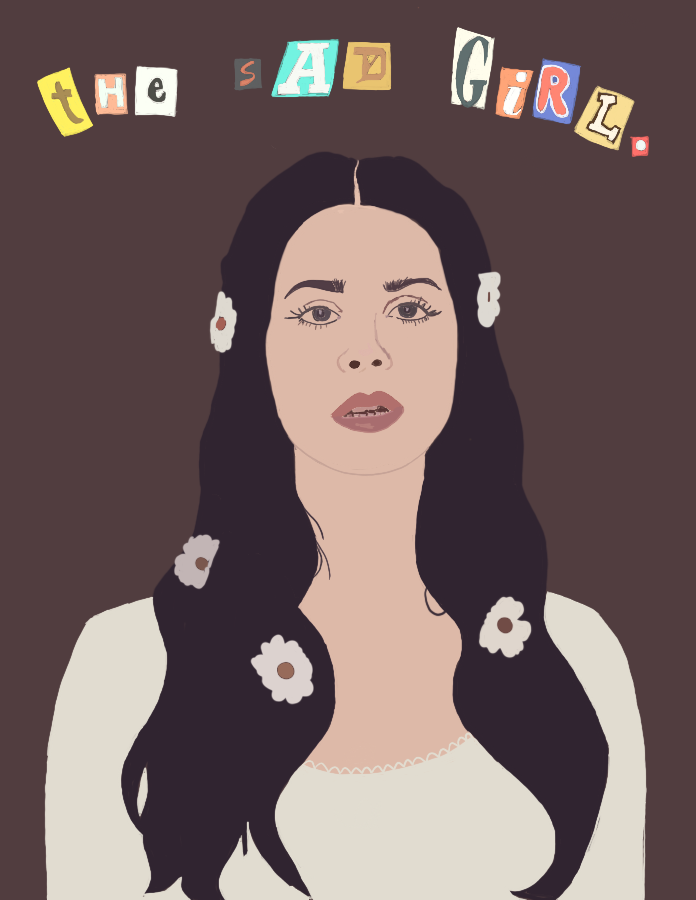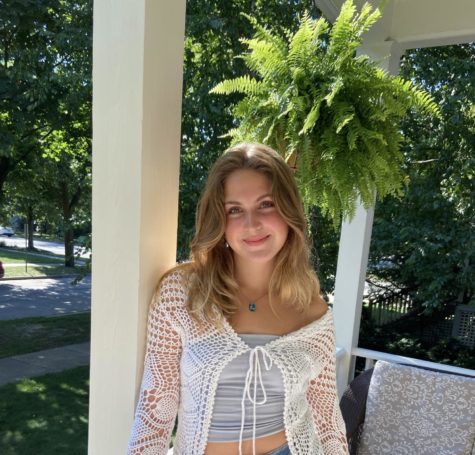Opinion | The “Sad Girl” trope is getting old
March 15, 2023
The year was 2020, the month was May, and I sat awake in my room at 3 am, rewiring my brain upon the discovery of Lana Del Rey’s complete discography. Reflecting back on this infatuation, it wasn’t really Del Rey’s music that I fell in love with. It was more so the identity that I felt came with being a fan of hers. I was allured by what I now know to be called “The Sad Girl”.
The Sad Girl and I have had quite the relationship since. Through embracing her aesthetic, her mindset, her lifestyle, I grew quite alienated from myself. I thought I was doing quite the opposite. The sad girls of the Internet are not the honest, “heart-on-her-sleeve” heroines we often think them to be. They are, in fact, operating within a system which rewards performance rather than humanity. The Sad Girl trope is one method of broadening the reach of online commodification into some of the most private inner-turmoils; mental health and insecurity in young women. With her sad poetry quotes and black nail polish, The Sad Girl asks us not how we can grow to feel good about ourselves, but how we can make our pain look good.
I took the bait that night in May of 2020, and I became something of a quintessential Sad Girl myself. Along the way, I noticed many things which ultimately led me to question her role in my life. Much of this revelation came when I simply asked myself, “Why do I need everyone to know how ‘sad’ I am?”
The glamorization of sadness or insecurity in women is nothing new. One quote which always strikes me about women in literature is one by Edgar Alan Poe; “The death of a beautiful woman is, unquestionably, the most poetical topic in the world.” Excusing the trademark Poe morbidity, this quote points to the role that women’s sadness, suffering and even death has played in the collective imagination. Through the patriarchal notion that women are more emotional, the expression of emotions, and ultimately, the sadness, in women has been lended a kind of beauty, or desirability. Even more so, I believe the insecurity that is so characteristic of The Sad Girl has become a sought-after trait; insecurity, especially in young women, all too often fosters a dependency on male validation. Chronic self-doubt in young women creates a space of lack, and we are told by patriarchy that this can be filled by male savior-complex-suitors, valiantly fixing your brokenness with their redeeming affection. Think of the Del Rey lyric, “Love me until I love myself”, or the One Direction boys– God bless their hearts– singing, “You don’t know you’re beautiful, that’s what makes you beautiful.” After all, what can fill a space of lack better than the male gaze?
The death of a beautiful woman is, unquestionably, the most poetical topic in the world.
— Edgar Allen Poe
With cultural reinforcers which teach young women that it is desirable to be, in some way, reliant on men, it’s no wonder that The Sad Girl came to be. Of course, Del Rey is the poster child of this trope. Lyrics such as “You like your girls insane” and “He knows me, every inch of my tar-black soul” did little to dissuade the notion that sadness is attractive, actually. Soon, the infamous tumblr.com was flooded with aesthetic pictures of girls with mascara running down their cheeks. These women were almost always white, thin women; since The Sad Girl was at its core a campaign to increase desirability in the eyes of patriarchy, it went hand-in-hand with other Eurocentric, body-shaming beauty standards. It operated very clearly in conjunction with these systems of oppression and domination. There were many iterations of “I told my therapist about you”, and who could forget the “sHE beLIEveD him” fiasco. I even found a picture featuring bright pink pills with a film filter over it and the word “medicated” written below. At this point it wasn’t just sadness that was in; it was full-blown mental illness. Nowadays, sad girls may be rebranded into “Phoebe Bridgers girls,” “Colleen Hoover readers,” “tote bag girls,” the exhausting list of interests and hobbies that dictate one’s identity as a young woman truly does go on and on. Ultimately, The Sad Girl was another very narrow and toxic measuring tool for young women to compare themselves to.
I admit, in my Sad Girl escapades, I was motivated by the idea that claiming The Sad Girl identity would somehow make me more desirable. It was wonderful news that insecurity was a patriarchy-sanctioned hot commodity, because I certainly had more of it than I knew what to do with. In her book “All The Women In My Brain: And Other Concerns,” actress and author Betty Gilpin writes fascinatingly about commodifying her sadness. Referring to the curated part of her brain as the “Barbie cell” and the more sad, complicated part as the “darkness”, she writes, “Then in the ultimate act of self-betrayal, I learned how to sell the darkness. I saw I could treat it as a fodder for the character the Barbie cell wanted to convince the world I was. Posing with a journal at Starbucks but not actually writing in it. Pulling at my sleeves in performed angst…Like some huckster salesmen selling blow-up doll witches on the outskirts of Salem.”
The fantasy that The Sad Girl meets the man of her dreams (some strange cross between Prince Charming and a licensed therapist, who probably listens to Fiona Apple) and lives happily ever after, never to be bothered by mental illness again, is just that: a fantasy. Dr. bell hooks writes in her book, “Communion: The Female Search For Love” about changes she noticed in her life as she grew more self-actualized and stable, saying, “More men were attracted to me and to other women I knew when we were untogether. This is because it’s easier to subordinate someone who does not feel good about herself or her life, or someone who may feel constantly insecure and afraid.” This perfectly encapsulates both why The Sad Girl exists and why it’s a trap. Sadness is deemed desirable because it is seen as a form of weakness, a mark of female subordination. Therefore, sadness does attract male attention, but it’s attention from a very sorry lot indeed.
Beyond the context for the existence of The Sad Girl, the consequences of this trope extend past the personal lives of the women who embrace it. The Sad Girl has been a long-standing figurehead in the widespread glamorization of mental illness. As the notion that “insecurity is in” gained traction, suddenly, having a mental illness only made you a real, through-and-through Sad Girl. Congratulations!
In viewing mental illness as something alluring rather than an incredibly difficult reality, lots of anti-recovery sentiments became mainstream. For starters, misinformation belittling the severity of mental health issues was widely accepted; condensing depression into sleepiness, anxiety into biting your nails, OCD into color-coding your pens, or ADHD into losing your phone. I do think much of this lack of nuance is the work of The Sad Girl; ultimately, even though her brand consists of things conventionally macabre and complex, she is still a brand, meaning she is not exempt from the rule of being palatable. The very complicated and painful reality of living with a mental illness is just not aesthetically pleasing enough.
Consequently, wearing these abridged versions of mental illness like badges was the name of The Sad Girl game, and thus, to address one’s mental illness and seriously endeavor on a road to recovery was to give up one’s most captivating trait. Although The Sad Girl’s grasp includes the romanticization of things like therapy and medication, engagement with it still requires one to place their mental health problems at the forefront of their identity, orienting all other facets of themselves around it, which is inherently anti-recovery. As someone who deals with mental illness, I understand that it’s an important part of many people’s identities, and therefore the common understanding and discussion of it among the people in their lives is crucial. Additionally, as a former Sad Girl, I understand that this is not the sort of thing promoted by Sad Girl rhetoric, which favors performing a surface-level, palatable version of mental health problems, and reinforcing that these problems are central to who you are as a human being by sharing little else about yourself. Sad Girls do not discuss things like healthy coping or self-reflection and improvement. They simply bask in their broken beauty.
Embracing this way of thinking seemed easy to me, because I never had to confront my mental illness. I could simply convince myself it was a good thing. I could flaunt a distilled version of living with mental illness and be rewarded by external validation. Inwardly, however, I was enabling my own problems and dishonestly representing how they were affecting me. When we have a widespread fetishization of insecurity and mental illness, we devalue things that can help us live happier lives. We chronically deny ourselves an honest discussion of mental illness, something which painfully erodes our relationship to self, in favor of these glamorized symbols of suffering.
I, clearly, strongly disagree with the manner in which The Sad Girl sparked conversations about mental health, but spark them she did, and I cannot help but be thankful for that much. Talking about mental health is obviously important, both for awareness and for cultivating community in something that can feel so isolating. Even the mental illness-related humor and light-heartedness that came with The Sad Girl package is beneficial in many cases; humor is a very real coping mechanism for many suffering with mental health issues, and joking about it or speaking of it in a playful manner can help to take those scary thoughts off their pedestal, to devalue the influence of mental illness in our lives. This is a fact which should never be overlooked. I only feel that mental illness should not be attached to some archetype of desirability, and it should not be incentivized for young girls to orient their entire online presence around the idea that they’re “sad”. At the crux of it, the patriarchal idolization of female suffering, insecurity, and emotional lack is intended to push women in the direction of subordination rather than empowerment and self-actualization. While the Sad Girl herself is not to blame for operating within a patriarchal society, women do not deserve to be defined by their pain in order to be deemed lovable.
I also want to clarify that I am not demeaning female artists or public figures who wish to talk openly about their mental health, or create art primarily focused on the sad parts of their lives. While I do think Lana Del Rey plays a bit more into the Sad Girl Syndrome than most by writing specifically about how her sadness makes her appealing to men, I’m not here to knock female artists whose discography mostly consists of ballads about heartache and insecurity. Sadness can be a wonderful muse, a jumping-off point for sincere self-reflection and fantastic, thought-provoking art. Women who embrace their pain in an honest, affirming way and cope through their art are incredibly powerful, because they are allowing themselves to truly feel and express their feelings authentically. This could not be more different from the disingenuous performance of sadness that I’m criticizing.
So, where are my beloved Sad Girl and I today? We have certainly parted ways; one of the biggest efforts I took to distance myself from her was deleting Tik Tok after I realized I had dug myself into an echo-chamber of anti-recovery sentiments and mental health misinformation. I also found that Tik Tok was often the stage on which I performed my Sad Girl routine. Since deleting it, I’ve been able to feel all of my Sad Girl feelings without feeling pressured to perform them; to exaggerate them or belittle them or wear them like a perfume. Moreover, I still love Phoebe Bridgers and Sylvia Plath, some of the saddest girls in the canon, with my entire heart, but I don’t necessarily feel tethered to them as if they are the sole indicator of my identity. Additionally, I don’t feel tethered to my mental illness, as if it is the one thing I have going for me.
Nobody should be whittled down into any archetype, ever. It is inherently dehumanizing and alienates one from a true sense of self. In the case of The Sad Girl, I’ve found her to be a particularly brutal force in the lives of young women navigating internal struggles with an audience of potentially millions on the Internet. Encouraging women to perform rather than communicate, glamorize rather than confront, remain in a place of emotional lack rather than grow into self-fulfillment, is a cruel, patriarchal mechanism of control. To counter this, we need to teach young people that they are valid in their feelings, whatever they may be, and that they don’t have to adhere to a prescribed role to be recognized. Full and complete humanity is the antithesis of archetypes like The Sad Girl, and thus, embracing one’s full and complete humanity is the only way to counter this demeaning way of thinking.






















